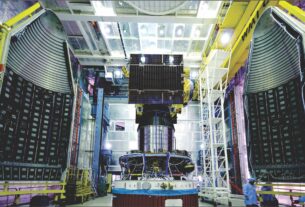The widespread and successful use of drones i.e., the UCAV in the Af-Pak region has demonstrated its efficacy and necessity in future warfare, especially in a low intensity conflict situation. However, the defence community, world over, is now looking into the possibility of deploying the combat drones in full scale war which can be deployed in the long range and long endurance mission. The drones are now gradually becoming part of the weapons package.
Indian armed forces will have to take a serious note of such drones which are gradually being inducted by them. In fact Pakistan has claimed to have developed a drone in collaboration with China and is reported to be using them on India-Pakistan border. Just a few years ago the US armed forces had a near monopoly in the use of drones in combat zones, but nowadays even a country like Pakistan is claiming to have developed drones that can be used on the Indian border. The use of lethal drones on the borders in South Asia can further lead to rise in tensions and mutual suspicions on each other. According to a Washington DC based think tank New America more than 70 countries have UAVs with surveillance capabilities, though only the US, UK and Israel have used armed drones in combat.
India has been acquiring drones since early last decade mainly for surveillance and photo-reconnaissance from Israel and has also been developing indigenously. India is investing a lot in developing such unmanned systems. Indian DRDO has an ambitious plan to develop a stealth combat plane, which will be unmanned and be able to launch missiles and drop bombs in the beyond visual range.
India’s acquisition plan
However, this ambitious project will take several years to fructify. So, Indian government is reported to have ordered the acquisition of combat drone Heron from Israel a few months ago, without disclosing it to the general public. These Herons will allow the Indian Army to carry out strikes overseas with zero loss possibility to its personnel. Only last September, the Indian MoD sanctioned the acquisition of ten killer drones Heron TP from Israel. More will be ordered later, from the Israeli Aircraft Industries. The Heron TP can be fitted with weapons to engage targets on the grounds. The deal has been estimated to be around US$ 400 million. These Herons are likely to enter service by the end of next year and will give the air force deep strike capability. Sensing its huge requirement for the Indian armed forces in future, a delegation of IAI is reported to have discussed its manufacture in India under the ‘Make In India’ program.
Meanwhile the Indian DRDO is also reported to be secretly working on the Indian Unmanned Combat Aerial Vehicle (IUCAV) program codenamed AURA (Autonomous Unmanned Research Aircraft). It has also been reported that the DRDO is making efforts to integrate missiles with the Rustam UAVs developed successfully by them.
However the sources in DRDO says that the AURA will be a stealth UCAV which can fire missiles, drop bombs and precision guided munitions. It has also been reported that UCAV’s design is similar to the Northrop Grumman’s B-2 Spirit Bomber. The design work is being carried out by the Aeronautical Development Agency, under secrecy. Its mission has been defined as Deep Penetration Strike, suppression of enemy air defences, strategic reconnaissance and electronic warfare.
The DRDO has been sanctioned Rs 8250 crores as project development cost. It will have stealthy shape, radar absorbent paint, composite materials and low absorbability features. In future it has been planned to provide the UCAV with air to air combat capability. The ADA has described the AURA as a “self-defending” high speed reconnaissance UAV with weapon firing capability. The AURA will cruise at a medium altitude and will be capable of carrying two or more guided strike weapons with on-board sensors for targeting and weapon guidance. The flight control system and data link packages of AURA will be designed and developed jointly by ADA and Defence Electronics Application Laboratory.
The AURA is being designed to fly at an altitude of 30,000 feet, weighing 15 tonnes and flying range of more than 3000 kms. It will have rail launching for the missiles, bombs and the Precision Guided Munitions. They will carry and will be powered by indigenously developed Kaveri engine. According to experts the flying wing concept designated the Indian Unmanned Strike Air Vehicle (IUSAV), which in fact is a derivative of flying wing UAVs like European Neuron and Boeing Phantom Bay. ADA plans to have first prototype flight by next year, but experts doubt their claim, considering the earlier failed aviation projects.
Former officers of the IAF say that the Air Force Headquarters is conscious of the fact that how LCA program has still not been realized after three decades of efforts. Hence the officials have assigned themselves this time with the ADA development work on AURA. The ADA has told the Indian Air Force that the delivery will begin from 2020. It has also been reported that Dassault, SAAB and BAE systems have offered collaborations to the DRDO for the IUSAV project.
Multi-mission capability
The US armed forces are using the unmanned remotely piloted aircraft to target suspected militants in the tribal areas of Pakistan. Since they are able to evade enemy attention and make precision strikes, they are used in a terrain where enemy forces are supposed to thrive and where manned flight is considered too risky. They are the eyes and also act as missile launchers of the forces, which can loiter over an area for hours and send back real imagery of the activities on the ground. The US Department of Defence expects sharp increase in demand for the use of drones from the US commanders world over, located in the combat zones like the Syria, Iraq, Afghanistan, Somalia and to gather intelligence in the pacific.
The US Army used its medium sized drones in Afghanistan and Pakistan and they carry large number of sensors in their body-comprising color and black and white TV, image intensifier, radar, infrared imaging low light conditions and lasers for targeting, and they can also carry laser guided missiles.
The flight operations of these bases are conducted from thousands of miles away-many of the drone operations are conducted from Creech air force base in Nevada. The MQ-IB Predator was mainly designed for intelligence activity and for identifying targets and reconnaissance. Later, in 2002 it was equipped with two Hellfire missiles with a range of eight kilometres. Nowadays the US drones are almost like unmanned fighter planes.
The latest MQ-9 Reaper was designed as a “ hunter-killer” system. It can be loaded with four Hellfire missiles and laser guided bombs like Paveway-II and GBU-12, which can fly with a speed of 370kmph, which is much faster than the Predator.
India intends to collaborate with the US companies for Raven and Puma drones, which are designed for close range military action, which allow troops to reconnaissance miles away from their positions The US company AeroVironment is working with the US army for more advanced UAVs and UCAVs. Raven is the most widely used hand launched drone in the world today. The wingspan of Raven is 4.5 feet and range 6.0 miles and has a flight time of 60-90 minutes.
The US Defence department is investing heavily in unmanned robotic technology, considering the changing nature of warfare in future. The enemies like the Islamic State can be effectively dealt with by robotics fighter planes only. Their real time locations can easily be targeted through the use of UAVs.
Since Indian armed forces are also facing similar combat situation from Kashmir to North Eastern part of the region and the borders with China and Pakistan needs constant vigil, the UAVs can be an effective replacement for round the clock manual observation of the enemy movements on the other side of the border.
If the UAVs are flown over the boundary lines with China and Pakistan, the need for manual patrolling in the dense forests and freezing borders would not be required. It has been reported that the China and the Pakistan have been flying the UAVs for border observation in recent years. India is also reported to be doing that, as in the dense forested mountainous terrain of the North East demands such an answer from the armed forces. However, India needs a stealth drone for silent observation of the borders along with the combat drones for undeclared action against terrorists across the borders.





